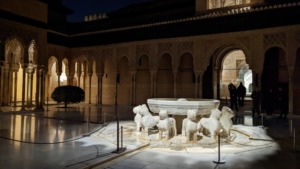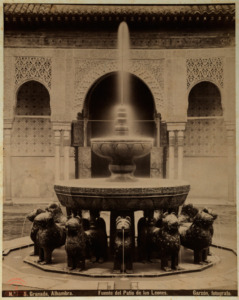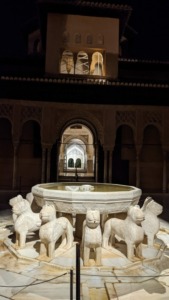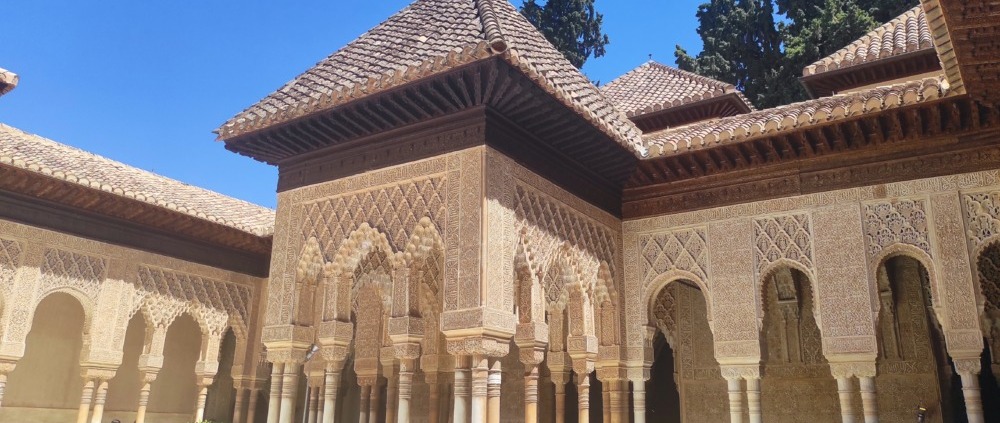TEN UNIQUE ASPECTS OF THE COURTYARD OF THE LIONS IN THE ALHAMBRA
If there is one emblematic place in the Alhambra, it is undoubtedly the courtyard of the lions in the Alhambra.
Built by the Nasrid Sultan Mohammed V in the second half of the 14th century, it is considered one of the jewels of Islamic art.
Throughout history, this courtyard has retained an enigmatic atmosphere that has inspired numerous legends.
In 2002, it underwent a 10-year restoration. This was one of the most complete restorations of the Alhambra, which allowed us to discover many more details about this wonderful palace.
Here are some of its secrets.

1- Do you know the name of the courtyard of the lions in Islamic times?
Over time, it got its current name thanks to the 12 stone lions surrounding the central fountain, but it was originally called Riyad Al-Said or the Happy Garden. A beautiful name for an extraordinary place that was undoubtedly a replica.
2- A highly unusual design
Its structure breaks with the usual patterns of the courtyards of Hispano-Muslim buildings. The elongated structure with a central water basin is abandoned in favour of a much more square courtyard surrounded by columns with a central fountain.
3- Why and when was the fountain equipped with a second bowl?

For more than a century, the famous fountain had a smaller second bowl. This was undoubtedly the result of an ill-considered restoration along Orientalist ideas. This was a consequence of fashion and the lack of information about the monument. In 1966, the fountain was restored to its original and present appearance.
4- What colour are the lions?
The restorer Carmen Tienza tells us how the restorers removed several layers of calcium carbonate, algae, etc. that covered the lions and gave them a dark colour. At the end of the restoration, we discovered white lions carved from the famous Macael marble. This extremely precise work took almost two years for each lion.
5- The fountain also speaks to us
The cleanliness of the fountain bowl also allows us to better understand the beautiful poem surrounding it, attributed to one of the great poets of the Nasrid court, Ibn Zamrak.
6- What do the lions symbolise?

The legends of the last centuries claim that they are the twelve symbols of the horoscope, the twelve hours of the day because it is a water clock, the twelve tribes of Israel and so on. None of these theories are true and it is part of the most romantic Alhambra.
7- Which factors have the greatest influence on the deterioration of the lions’ condition?
There are two. One is the great differences in temperature to which the stone is exposed and the other is the components that the water carries with it, such as limescale, micro-organisms, etc. After restoration, both factors are mitigated or even completely eliminated. Now the temperature of the water can be controlled and lowered if necessary. The water is purified before it reaches the fountain and the lions are covered at night.
8- Which famous person engraved their name?
Although it may seem barbaric today, in another era, in 1831, famous people who visited the Alhambra left their little graffiti. This was the case with the British romantic writer Richard Ford, whose initials are preserved on the fountain cup.
9- Do you know why the fountain plate was restored on the spot?
As you have probably already guessed, it is because of its heavy weight. It weighs more than 3000 kg and is therefore very difficult to transport. However, the lions were taken to the restoration workshops.
10- Did you know that no two lions are alike?
At first glance it may seem that they are all the same, but in reality every lion is different. The mouth, the fur, the tail or the ears are different. Each one of them is unique, special and one of a kind.
If you want to discover all the secrets of one of the most visited monuments in the world, don’t any of miss my guided tours.
A tour tailored to you and your interests is waiting for you.
You can reach me at info@visitgranada.com or by Whatsapp at +34 617359043.





Leave a Reply
Want to join the discussion?Feel free to contribute!